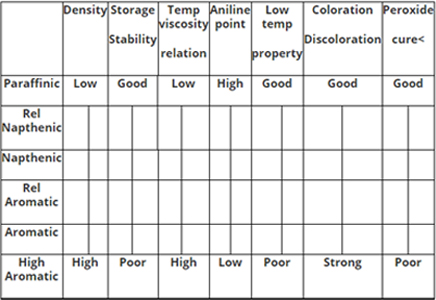CHANDROL PROCESS OILS
Rubber, a product that forms integral and inseparable part of our daily life knowingly or unknowingly we use rubber in many ways from Tyres of vehicles to gas pipe, to shoe soles, from door mats to yoga mats, Rubber is a versatile product occurring naturally as well as artificially produced in large petrochemical plants.
During the process of making rubber goods the complex process involves mixing of various chemicals to enhance the properties for resistance against heat, sunlight, pollution and better life, one main ingredient in any rubber is a process oil which helps in proper mixing of the chemicals without damaging or changing independent properties of each chemicals, RPO is an extremely important part of rubber compounding and must be carefully chosen.
Chandrol process oils has a wide range of products for each application, for process of rubber which is naturally occurring as well as synthetically made, for high temperature application to application in low temperatures areas like polar regions or mountain tops.
Our Range of process oils are based on three major categories.
- Paraffinic RPO
- Naphthenic RPO
- Aromatics RPO
PARAFFINIC RPO
Paraffinic oils are the most commonly used process oils in rubber compounding . they come under type 3 classification of BIS and are available in number of viscosity grades depending on the application. Use of Chandrol paraffinic process oils permits the compounds to achieve efficient processing during mixing, extrusion, moulding and other operations.
NAPHTHENIC RPO
Naphthenic process oils have minimum of aromatic and hence qualifies as a GREEN OIL OR SAFE PROCESS OIL from HSE viewpoint. The use of naphthenic oils ensures good solvency and capability and enables avoidance of Aromatic oils Rubber compounding.
AROMATIC RPO
Aromatic process oils are commonly specified for rubber compounding. They come under Type 1 of BIS classification. The solubility properties of Aromatic oil is considerably superior to those of paraffinic oils particularly. This is of great use in compounding rubbers with elastomers such as SBR and natural rubber for example.
RAE OILS ( RESIDUAL AROMATIC EXTRACT TYPE )
RAE is a high viscosity aromatic process oil made from a residual oil fraction. It is used as an high solvency extender oil in rubber and tyres confirming to latest standards of minimum PCA content.
TDAE (TREATED DISTILLATE AROMATIC EXTRACT)
This environmentally friendly process oil has wide applications in tyres, tape and rubber industries where the oil remains in the final product. As specified in EU/2005/69/EC the polycyclic aromatic content is less than 3% by DMSO extract IP346 Method while maintaining aniline point of around 90. Selecting the right process oil for your mix is very important, below is a brief guideline for the same.
PROCESS OIL SELECTION FOR RUBBER COMPOUNDING
Rubber compounding is the operation of selecting and blending the right Elastomers (“Rubbers”) with other ingredients in order to get optimal performance and cost of Rubber goods made for various applications. The ingredients are chosen in the following order
- Polymer (Natural or Synthetic rubber)
- Fillers or reinforcing agent
- Antioxidants and Anti-ozonants
- Plasticizers and Process oils
- Bonding agent or adhesive (if needed)
- Vulcanization system (curing agent, accelerator or coagent)
The benefits of using Processing oils are described here below:Mixing: Faster filler incorporation and better dispersion, reduced viscosity, improved release, lower dump temperature, reduced mix times
Processing: Faster and easier calendaring and extrusion, improved release, less power consumption
Curing and Molding: Faster cavity fill at lower operating pressure, reduced stress in molded parts, shorter cycle times and improved release.
Importance of controlling Viscosity Gravity constant (VGC) of Process oils. This property is measured by ASTM D2501 and ranges from 0.82 for Paraffinic oils to 0.90 for Naphthenic oils and 0.95 for Aromatic oils. Higher VGC leads to high tensile and tear strength and faster acceleration in Diene rubbers, however it also leads to higher heat buildup, lower resilience, poor low temperature properties and greater tendency for crack growth. Hence the optimization of Process oil blend is important for every compound.
Nowadays it is also important to minimize use of Aromatic oils from Health and Safety viewpoint.
- N.B.: + compatible, – Incompatible, 0 Conditional compatible
- NR is Natural rubber(Poly-isoprene)
- SBR is Styrene Butadiene rubber
- BR is Butadiene rubber
- NBR is Nitrile rubber
- CR is Neoprene
- CSM is Hypalon
- EPDM is Ethylene Propylene rubber
- IIR is Butyl rubber (Isobutylene Isoprene rubber)
GENERAL PROPERTIES OF PROCESSING OILS

COMPATIBILITY OF PROCESSING OILS WITH DIFFERENT RUBBERS

